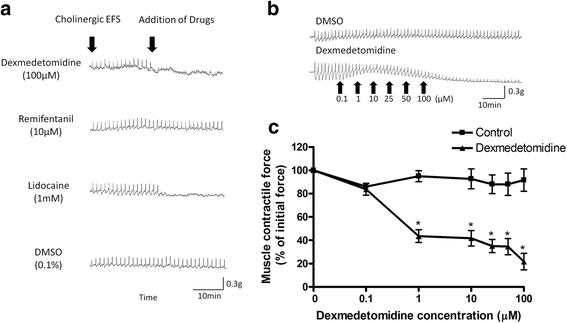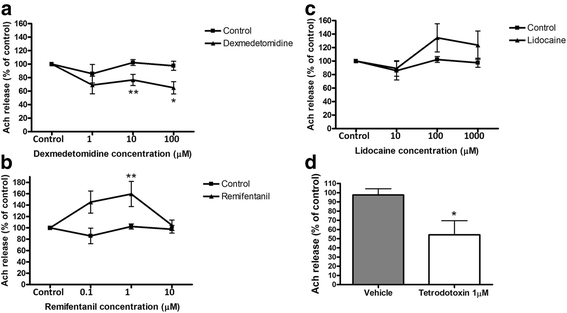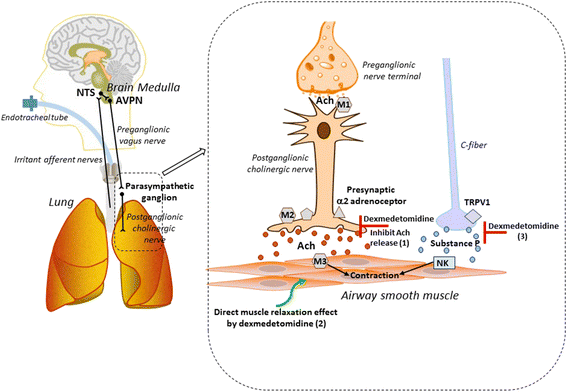Dexmedetomidine's inhibitory effects on acetylcholine release from cholinergic nerves in guinea pig trachea: a mechanism that accounts for its clinical benefit during airway irritation
- PMID: 28356076
- PMCID: PMC5372301
- DOI: 10.1186/s12871-017-0345-z
Dexmedetomidine's inhibitory effects on acetylcholine release from cholinergic nerves in guinea pig trachea: a mechanism that accounts for its clinical benefit during airway irritation
Abstract
Background: Airway instrumentation can evoke upper airway reflexes including bronchoconstriction and cough which can cause serious complications including airway trauma, laryngospasm or bronchospasm which may in turn lead to difficulty with ventilation and hypoxemia. These airway events are mediated in part by irritant-induced neuronal modulation of airway tone and cough responses. We investigated whether the commonly used anesthetic agents dexmedetomidine, lidocaine or remifentanil attenuated neuronal and airway smooth muscle responses in the upper airways of guinea pigs.
Methods: The ability of dexmedetomidine, lidocaine or remifentanil to attenuate direct cholinergic nerve stimulation, C-fiber stimulation or direct smooth muscle contraction were studied using isolated tracheal rings from male guinea pigs under four paradigms; (1) the magnitude of contractile force elicited by cholinergic electrical field stimulation (EFS); (2) the amount of acetylcholine released during cholinergic EFS; (3) the direct airway smooth muscle relaxation of a sustained acetylcholine-induced contraction and (4) the magnitude of C-fiber mediated contraction.
Results: Dexmedetomidine (1-100 μM) and lidocaine (1 mM) attenuated cholinergic 30Hz EFS-induced tracheal ring contraction while remifentanil (10 μM) had no effect. Dexmedetomidine at 10 μM (p = 0.0047) and 100 μM (p = 0.01) reduced cholinergic EFS-induced acetylcholine release while lidocaine (10 μM-1 mM) and remifentanil (0.1-10 μM) did not. Tracheal ring muscle force induced by the exogenous addition of the contractile agonist acetylcholine or by a prototypical C-fiber analogue of capsaicin were also attenuated by 100 μM dexmedetomidine (p = 0.0061 and p = 0.01, respectively). The actual tracheal tissue concentrations of dexmedetomidine achieved (0.54-26 nM) following buffer application of 1-100 μM of dexmedetomidine were within the range of clinically achieved plasma concentrations (12 nM).
Conclusions: The α2 adrenoceptor agonist dexmedetomidine reduced cholinergic EFS-induced contractions and acetylcholine release consistent with the presence of inhibitory α2 adrenoceptors on the prejunctional side of the postganglionic cholinergic nerve-smooth muscle junction. Dexmedetomidine also attenuated both exogenous acetylcholine-induced contraction and C-fiber mediated contraction, suggesting a direct airway smooth muscle effect and an underlying mechanism for cough suppression, respectively.
Keywords: Airway Management; Anesthetic Agents; Bronchodilation; Muscle Relaxation; Smooth Muscle; α2 adrenoceptor agonist.
Figures





Similar articles
-
Propofol preferentially relaxes neurokinin receptor-2-induced airway smooth muscle contraction in guinea pig trachea.Anesthesiology. 2010 Jun;112(6):1335-44. doi: 10.1097/ALN.0b013e3181d3d7f6. Anesthesiology. 2010. PMID: 20461005 Free PMC article.
-
Potentiation by endothelin-1 of cholinergic nerve-mediated contractions in mouse trachea via activation of ETB receptors.Br J Pharmacol. 1995 Feb;114(3):563-9. doi: 10.1111/j.1476-5381.1995.tb17176.x. Br J Pharmacol. 1995. PMID: 7735683 Free PMC article.
-
Influence of endothelin-1 on cholinergic nerve-mediated contractions and acetylcholine release in rat isolated tracheal smooth muscle.J Pharmacol Exp Ther. 1996 Dec;279(3):1142-7. J Pharmacol Exp Ther. 1996. PMID: 8968335
-
Innervation of airway smooth muscle. Efferent mechanisms.Pharmacol Ther. 1987;32(2):107-30. doi: 10.1016/0163-7258(87)90055-6. Pharmacol Ther. 1987. PMID: 2885861 Review.
-
Nociceptin effects in the airways.Peptides. 2000 Jul;21(7):995-8. doi: 10.1016/s0196-9781(00)00239-4. Peptides. 2000. PMID: 10998533 Review.
Cited by
-
Bronchoscopy examination of a patient with tracheobronchial injury having intractable cough: Role of sevoflurane sedation and paraoxygenation.Ann Card Anaesth. 2021 Jan-Mar;24(1):121-123. doi: 10.4103/aca.ACA_182_19. Ann Card Anaesth. 2021. PMID: 33938855 Free PMC article. No abstract available.
-
Dexmedetomidine for prevention of postoperative pulmonary complications in patients after oral and maxillofacial surgery with fibular free flap reconstruction:a prospective, double-blind, randomized, placebo-controlled trial.BMC Anesthesiol. 2020 May 27;20(1):127. doi: 10.1186/s12871-020-01045-3. BMC Anesthesiol. 2020. PMID: 32460699 Free PMC article. Clinical Trial.
-
Development and Validation of a Risk Nomogram Model for Perioperative Respiratory Adverse Events in Children Undergoing Airway Surgery: An Observational Prospective Cohort Study.Risk Manag Healthc Policy. 2022 Jan 6;15:1-12. doi: 10.2147/RMHP.S347401. eCollection 2022. Risk Manag Healthc Policy. 2022. PMID: 35023976 Free PMC article.
-
Perioperative Care of the Pediatric Patient and an Algorithm for the Treatment of Intraoperative Bronchospasm.J Asthma Allergy. 2023 Jun 23;16:649-660. doi: 10.2147/JAA.S414026. eCollection 2023. J Asthma Allergy. 2023. PMID: 37384067 Free PMC article. Review.
-
Dexmedetomidine stops benzodiazepine-refractory nerve agent-induced status epilepticus.Epilepsy Res. 2018 Mar;141:1-12. doi: 10.1016/j.eplepsyres.2018.01.010. Epub 2018 Jan 31. Epilepsy Res. 2018. PMID: 29414381 Free PMC article.
References
-
- Larsen GL, Fame TM, Renz H, et al. Increased acetylcholine release in tracheas from allergen-exposed IgE-immune mice. Am J Physiol. 1994;266:L263–L270. - PubMed
MeSH terms
Substances
Grants and funding
LinkOut - more resources
Full Text Sources
Other Literature Sources

